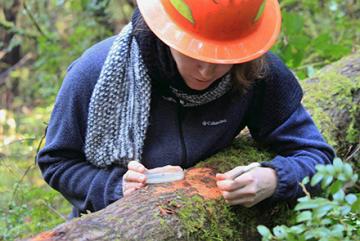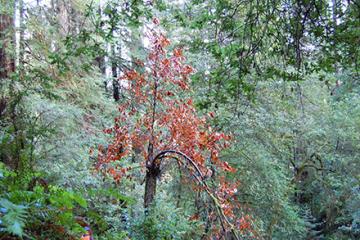Tracking and Fighting a Tree Killer

OSU grad student Laura Sims samples P. ramorum, also known as “sudden oak death,” from a fallen tree. (Photo by Nik Grunwald, D4741-1)
Potatoes and oak trees don’t have a lot in common, but there is one thing, and it isn’t good – a fungal-like plant pathogen in the genus Phytophthora. One of the many invasive pathogens contained in this genus, P. infestans, was responsible for the Irish potato famine.
Since the mid-1990s, though, Phytophthora has been attacking forest trees along the West Coast, with the pathogen P. ramorum, also known as “sudden oak death” (SOD). SOD was first detected in the San Francisco Bay Area; it has since spread throughout California. In 2001, SOD was discovered in southwest Oregon where it infected tanoaks trees. The discovery led to the formation of an interagency team that included researchers from the Agricultural Research Service (ARS) and Oregon State University (OSU), to develop strategies to mitigate the impacts of SOD.
SOD has killed as many as 43 million trees from 2012 to 2019.
“Initial eradication efforts slowed the epidemic’s progress significantly, but were unable to completely eradicate the pathogen,” said Nik Grunwald, research plant pathologist at the ARS Horticultural Crops Research Lab in Corvallis, OR.
According to Grunwald, ARS and OSU conducted disease diagnostics and epidemiology of the pathogen in ornamental nurseries because flowering plants in the Rhododendron and Pieris families host Phytophthora and have been implicated in the spread of sudden oak death to wildland forests.

Dead tanoak in southwest Oregon. Sudden oak death killed as many as 43 million trees from 2012 to 2019. (Photo by Nik Grunwald, D4742-1)
Using genetic analysis, the team discovered that trees in Oregon have been attacked by three distinct lineages of the pathogen P. ramorum, starting with NA1 (North American) in 2001 and followed by a European variant, EU1, in 2015, and NA2 this year. All told, the three lineages killed and damaged tanoak, coast live oak, and several conifer species – including Douglas fir, western hemlock, grand fir, and larch.
According to research partner and OSU plant pathologist Jared LeBoldus, the SOD mitigation plan included applying an herbicide to infected trees using the “hack-and-squirt” method. As the name implies, hack-and-squirt introduces the herbicide to the infected tree using spaced cuts around the trunk and then squirting the herbicide into the gash. In addition, containment practices included cutting down and burning infected trees and, in some cases, treating high-value individual trees with systemic fungicide.
“This research provides critical insights for regulatory agencies and forest managers to understand pathways of introduction of the SOD pathogen and helps them prioritize their management efforts,” Grunwald said. – by Scott Elliott, ARS Office of Communications

